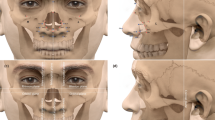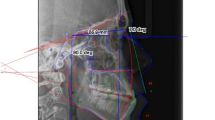Abstract
Purpose
The aim of this study was to investigate the transversal relationships between two cephalometric landmarks and lines on the face using ovale, rotundum, greater palatine and infra-orbital foramina as references.
Method
Thirty-four children dry skulls, 19 males and 15 females aged 0–6 years, were examined by computed tomography scanning by using constructed tomographic axial and frontal planes. The cephalometric transversal dimensions of the face skull were measured between the right and left landmarks from the orbital lateral wall and from the zygomatic arch. The cephalometric transversal dimensions of the base skull were measured between the right and left ovale, rotundum, greater palatine and infra-orbital foramina.
Results
Statistical analysis using partial correlations, regardless of the age, showed strong relationships (p < 0.05) among transversal measurements with nerve canal openings and transversal distances of skull face.
Conclusion
We showed that the cranial base transversal growth was very strongly related to facial transversal growth from the postnatal period up to 6 years of age.








Similar content being viewed by others
References
Aknin JJ (2007) La Croissance Cranio-Faciale. SID, Paris
Couly G (1991) Croissance cranio-faciale du foetus et du jeune enfant. Encycl Méd Chir Stomatologie. Elsevier, Paris, p 11
Crocquet M, Laude M, Thilloy G (1993) Morphogenetic role of the trigeminal nerve. A new approach to facial architecture. Bull Assoc Anat 77:5–8
Diouf JS, Crocquet M, Ngom PI, Danguy M, Diagne F, Diop-Ba K, Badiane A (2010) Value of trigeminal nerve foramina-based approach in the cephalometric study of sagittal morphology of Senegalese subjects. Orthod Fr 81:147–155
Enlow DH (1990) Facial growth. Saunders, Philadelphia
Harnet JC, Lombardi T, Lutz JC, Meyer P, Kahn JL (2007) Sagittal craniofacial growth evaluated on children dry skulls using V2 and V3 canal openings as references. Surg Radiol Anat 29:589–594
Kjaer I (1990) Correlated appearance of ossification and nerve tissue in human fetal jaws. J Craniofac Genet Dev Biol 10:329–336
Kovacs AF, Sauer SN, Stefenelli U, Klein C (2008) Growth of the orbit after frontoorbital advancement using nonrigid suture vs rigid plate fixation technique. J Pediatr Surg 43:2075–2081
Lieberman DE, Pearson OM, Mowbray KM (2000) Basicranial influence on overall cranial shape. J Hum Evol 38:291–315
Raadsheer MC, van Eijden TMGJ, van Ginkell FC, Prahl-Andersen B (1999) Contribution of jaw muscle size and craniofacial morphology to human bite force magnitude. J Dent Res 78:31–42
Ranly DM (1980) A synopsis of craniofacial growth. Appleton-Century-Crofts, New York
Ricciardelli EJ (1995) Embryology and anatomy of the cranial base. Clin Plast Surg 22:361–372
Sejrsen B, Jakobsen J, Skovgaard LT, Kjaer I (1997) Growth in the external cranial base evaluated on human dry skulls, using nerve canal openings as references. Acta Odontol Scand 55:356–364
Sejrsen B, Kjaer I, Jakobsen J (1996) Human palatal growth evaluated on medieval crania using nerve canal openings as references. Am J Phys Anthropol 99:603–611
Weijs WA, Hillen B (1986) Correlations between the crosssectional area of the jaw muscles and craniofacial size and shape. Am J Phys Anthropol 70:423–431
Conflict of interest
We declare that we have no conflicts of interest in this contribution.
Author information
Authors and Affiliations
Corresponding author
Rights and permissions
About this article
Cite this article
Harnet, J.C., Lombardi, T., Manière-Ezvan, A. et al. Transversal craniofacial growth evaluated on children dry skulls using V2 and V3 canal openings as references. Surg Radiol Anat 35, 757–763 (2013). https://doi.org/10.1007/s00276-013-1125-1
Received:
Accepted:
Published:
Issue Date:
DOI: https://doi.org/10.1007/s00276-013-1125-1




